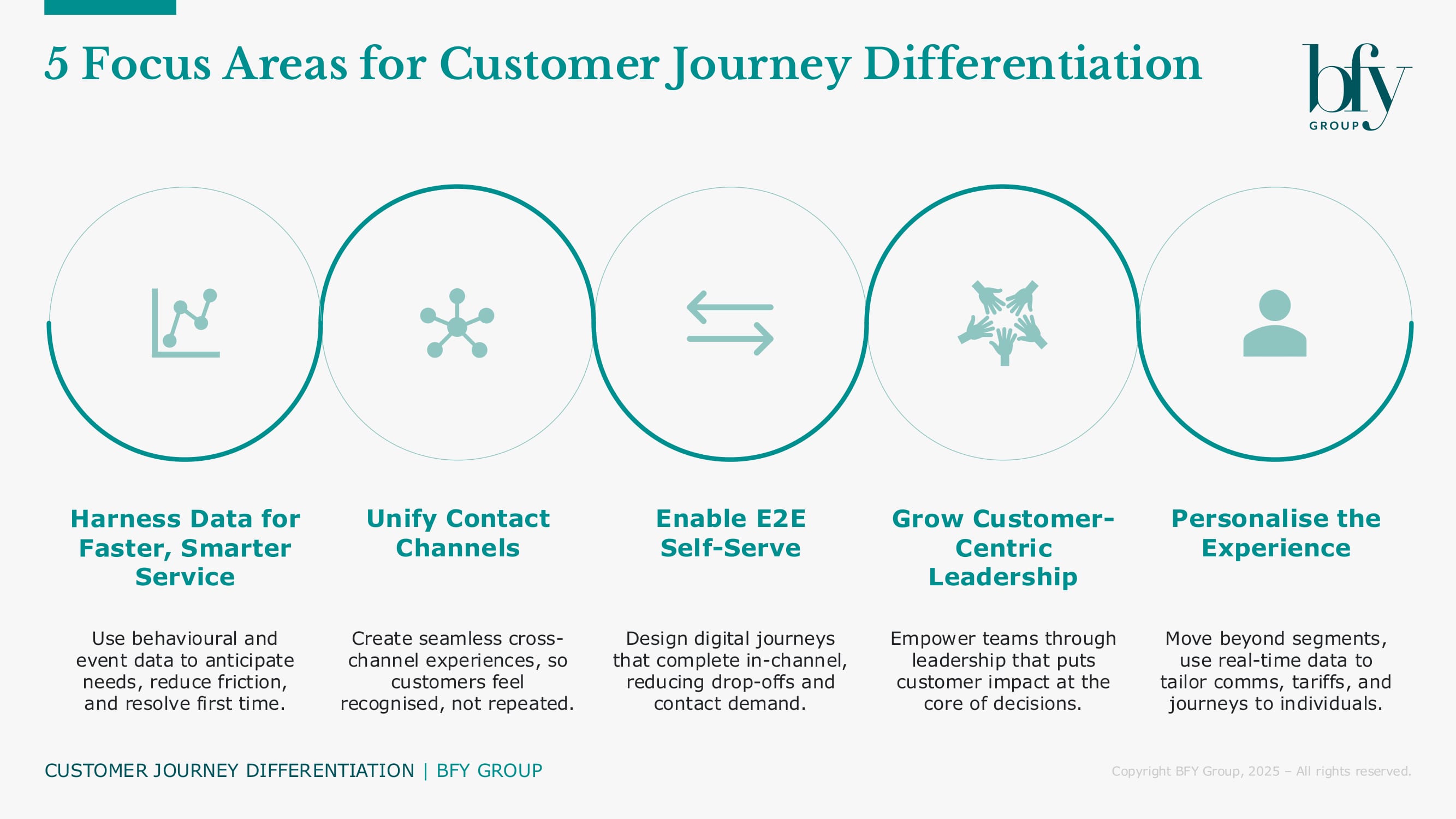Market share gain and great customer service are becoming increasingly linked in Energy. But as suppliers invest in new operating systems, with many opting for the same or similar providers, how will suppliers differentiate their servicing offering to create a competitive advantage?
Octopus’ market share has risen in recent years, focusing their marketing on great pricing and great service. Point in time comparisons may show that Octopus haven’t always provided the lowest kWh unit price, but when customers see the offering of great service - validated by champions like ‘Which?’ – (alongside a broad product offering) it has a positive impact on customer choice.
With many suppliers adopting similar operating systems (we’ve recently seen large suppliers move to Kraken), it’s possible that a similar customer experience will be delivered across the sector. However, there’s an opportunity for suppliers to look ahead and focus on customer journey differentiation, to create a better customer experience when using the same operating system as competitors.
We’ve explored this opportunity below, sharing five focus areas to drive customer journey differentiation.

1) Use data to drive differentiation and faster resolutions
Leveraging data is crucial to build a deeper understanding of customer behaviour. What steps are your customers taking before eventually making inbound contact? How can these be addressed to enable easier self-serve or a simpler outcome for the customer?
Also, consider whether you fully understand current key customer events. Does your understanding give a full view of the customer, and how can you use this to remove hassle and drive higher first-time resolution? For example, a home move will be a very stressful period of time for a customer, and if retaining their supplier is made as easy as possible, it’s one less thing to worry about. How can this be factored into the move journey, and the steps associated with it?
2) Integrate contact channels for consistent outcomes
Increasing the visibility of, and linkage between interactions will ensure customers don’t experience a different outcome via different servicing routes.
An advisor answering a customer’s call with “I saw you tried to do X on the app before you called us, can I help you with that?” creates a completely different experience to asking “How can I help?”, without any context.
3) Strive for ‘pure’ journey completion
If a customer starts a process online, how can you ensure this remains in the channel end-to-end, without requiring completion elsewhere? Getting this right will drive up ‘right first time’ and avoid the need for assistance calls from a customer who was happy to self-serve, but requires an understanding of exceptions and the ability to design ways to cover these.
It’s worth being clear on whether customer self-serve journeys are purely designed as an operational efficiency route to reduce demand/servicing cost; or whether they can be created with the lens of a sales/retention channel, driving wins through customer simplicity.
4) Develop customer-focused leaders
Leaders that drive engaged and empowered teams, with clear direction, can ensure customer experience and associated journeys are aligned to all decision making. This flows right through into team missions, daily huddles, reporting and performance management.
If leaders can provide clarity on how their specific team impacts customers, these teams will become more empowered to collaborate with other teams, enabling a unified approach to customer experience. A CEO driving a focus on customer experience could eventually move on, but if the entire workforce has ingrained this focus through leaders with ‘customer’ at the forefront of their leadership development, the entire company will always put customers at the heart of decision making.
5) Personalise experiences to enable customer benefits
The right data can enable customer-specific marketing and engagement approaches, as well as tariff offerings and usage reduction opportunities. There are real direct links between personalisation and customer satisfaction. Customers are more inclined to return to a store or online platform that understands their preferences, allowing easier decision making, as non-relevant items are already filtered out.
Market-wide Half-Hourly Settlements (MHHS) is on the horizon, and this is a key enabler of new innovative services, tariffs and offerings, which could be highly personalised to specific types of users.
Journeys that don’t follow a linear path, but instead feel directly relevant to the customer, can enhance the experience completely, driving a stronger connection to the brand and increasing loyalty/retention.
Laying the foundations for unique servicing, and competitive advantage
We know that pricing, and to some extent products can easily be copied; but personalised servicing that creates interactions unique to each customer cannot be replicated.
Often, we see recommended products, particularly from online retailers, but as customer expectations have changed, this personalisation now spans the entire customer experience. Those looking for a competitive advantage shouldn’t be thinking about ‘customer segments’ or ‘personas’, but each individual customer – with servicing, comms, products, and energy saving tips that are individual to them.
This is only possible by investing in data management and analytics initially; which in itself may require a shift in operating approaches and processes, to enable quicker data accessibility at a real time level.
It’s also where the parallel importance of great leadership comes in, to manage this change and ensure teams are 100% aligned on the direction of travel and what it will lead to. Particular value could be gained by looking at journeys that currently cause the most customer challenges and commercial impacts, such as losses at key events like a home move.
Now’s the time to stand out for energy suppliers
Data from Forbes shows companies that lead in customer experience outperform laggards by nearly 80%; and 84% of companies that work to improve their customer experience report an increase in their revenue. Not only that, 86% of customers were willing to pay a premium for an enhanced experience.
We know the road to improvement is 100% possible, as we see it happen elsewhere in online retailers such as Amazon; where your individual account drives what you see, which products are marketed to you, and the specific offers available.
Customer experience like this has become the new normal, and in an energy market where suppliers are adopting similar customer servicing systems, there’s no better time to invest in the measures that drive personalised customer journeys, and create a competitive edge.
For more on the opportunities for customer journey differentiation in today’s market, and how you can realise a competitive advantage, contact Kevin Scott.
Kevin Scott
Director
Kevin leads client engagements with a laser focus on empowering clients to navigate large-scale events and market challenges.
View Profile

